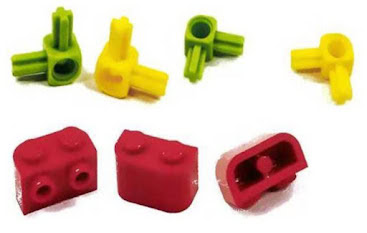In Decision C-211/24 – LEGO A/S v Pozitív Energiaforrás Kft. the CJEU have confirmed that the ‘informed user’ in the context of considering infringement of a registered design according to Art. 8(3) CDR should be understood as someone who is particularly observant and knowledgeable, often due to personal experience or extensive knowledge of the sector.
The informed user is also confirmed as not being an ‘expert-level’ individual whose perception is primarily driven by technical considerations. Thus the CJEU have confirmed that appearance is central under the EU Design Regulation, even when technical interconnection or modularity are being considered.
Background
LEGO A/S (‘LEGO’) owns the following registered Community designs (‘RCD’) for ‘building blocks from a toy building set’ (Locarno class 21.01):
– RCD no. 001950981-0001
– RCD no. 002137190-0002
The defendant, Pozitív Energiaforrás Kft. (‘Pozitív Energiaforrás’), imported building sets into Hungary, which contained, amongst others, the following parts that LEGO alleged infringed LEGO’s design rights,
Accordingly the sets were seized by Hungarian Customs because of potential infringement and LEGO began an infringement action against Pozitív Energiaforrás before a Hungarian court. This resulted in two questions being referred to the CJEU, namely:
31 In those circumstances, the Fővárosi Törvényszék (Budapest High Court) decided to stay the proceedings and to refer the following questions to the Court of Justice for a preliminary ruling:
‘(1) In a case such as that in the main proceedings, in which the holder [(the applicant)] relies on a [Community] design protected under Article 8(3) of [Regulation No 6/2002] in connection with one or more building blocks from a toy building set made by the defendant which perform the same assembly function as the blocks in the applicant’s design, is it compatible with EU law for the courts, when determining the scope of protection, within the meaning of Article 10 of [Regulation No 6/2002], of the applicant’s design,
– to take as their point of reference an informed user who, in respect of the function of the design and that of the product, possesses the technical knowledge to be expected of a sectoral expert,
– to consider an informed user to be one who compares the applicant’s design and the defendant’s product by carrying out a thorough, technical and methodical examination, and
– to assume that the informed user’s overall impression of the design and of the product is formed primarily of a technical opinion?
(2) In the event that, in a case as described above, it is to be concluded that the protection conferred by the applicant’s [Community] design extends to one or a small number of pieces of the defendant’s toy building sets, the number of which is nonetheless small in relation to the total number of building blocks, is it compatible with EU law for a court to have discretion to dismiss the claim for a prohibition on the continued importation of the toy building set into the country, after taking into consideration the partial nature of the infringement, the limited severity and extent of the infringement in relation to the product as a whole, and the interests associated with the unrestricted trade in a toy building set which is for the most part uncontested, those being classified as “[special] reasons” for the purposes of Article 89(1) of [Regulation No 6/2002]?’
C211/24 Decision, paragraph 31
First question
Thus the central point of the first question relates to the identity of the nominal informed user through whose eyes the individual character of a design is considered and thus whether a potentially infringing design produces a different overall impression with respect to a registered design.
In this case the registered design covers a modular system. Thus features of appearance that allow interconnection (cf Art. 8(3) CDR) must, unlike connecting features of non-modular system referred to in Art. 8(2) CDR, be taken into account when assessing the “overall impression.”
The CJEU summarised the situation thus:
26 The referring court is uncertain as to what abilities the ‘informed user’ referred to in Article 10 of Regulation No 6/2002 is supposed to possess when it comes to assessing the overall impression produced on him or her by such designs. In particular, it seeks clarification as to whether the scope of that concept, as it results in particular from the judgment of 20 October 2011, PepsiCo v Grupo Promer Mon Graphic (C281/10 P, EU:C:2011:679), namely that of a user who is not an expert or specialist capable of observing in detail the minimal differences that may exist between the designs at issue, can be applied in the context of Article 8(3) of Regulation No 6/2002. According to that court, it cannot be ruled out that, in view of the exceptional nature of the protection conferred by Article 8(3) of Regulation No 6/2002, such a user should be regarded as being a user who possesses technical knowledge and observational and analytical capabilities comparable to those which prevail, in patent law, when it comes to assessing whether an activity is inventive.
27 In that regard, the referring court is of the view that, if the concept of ‘informed user’, for the purposes of Article 8(3) of Regulation No 6/2002, were not to be defined by reference, inter alia, to the capability of such a user, in the light of his or her technical expertise, to observe in detail the designs at issue and to detect the minimal differences that may exist between them, that could lead to such differences being regarded as impossible to detect as part of an overall perception of those designs, so that it would become, de facto, impossible to work around the Community designs which protect them.
C211/24 Decision, paragraphs 26-27
Thus the question from the Hungarian court is effectively requesting clarity as to the extent of the abilities of the informed user. Are they (i) a “sectorial expert” capable of discerning and appreciating the smallest technical details; or (ii) someone who is particularly observant and knowledgeable, often due to personal experience or extensive knowledge of the sector. This latter definition was given in CJEU Decision C-281/10P and thus the Hungarian Court sought to know whether they should use the original definition of the informed user, i.e. (ii), above, or define the informed user as being a “sectorial expert” as in (i). above.
Article 10 of the Community Design Regulation (“CDR”; now EU Design Regulation), governs the scope of protection of a registered design wherein “”1. The scope of the protection conferred by a Community design shall include any design which does not produce on the informed user a different overall impression.
Thus in the context of Article 10 CDR, the CJEU concluded that:
58. […] Article 10 of Regulation No 6/2002 must be interpreted as meaning that the scope of protection of a design under Article 8(3) of that regulation must be assessed by reference to the overall impression produced by that design on an informed user who, without being a designer or a technical expert, knows the various designs which exist in the sector concerned, possesses a certain degree of knowledge with regard to the features which those designs normally include and, as a result of his or her interest in the products concerned, shows a relatively high level of attention when he or she uses them as components of the modular system of which they form part, and not on a user who, possessing technical knowledge similar to that which may be expected of a sectoral expert, examines the design concerned down to the smallest detail and whose overall impression is based primarily on technical considerations.
C211/24 Decision, paragraphs 58
Thus the nature of the informed user stays the same, i.e. as noted in (ii), above and defined in CJEU Decision C-281/10. We note that the CJEU stated specifically that
49 There is nothing in the wording or context of Regulation No 6/2002 to indicate that that concept of ‘informed user’ should be interpreted differently where the protection conferred by a Community design falls within the scope of Article 8(3) of that regulation.
C211/24 Decision, paragraph 49
Second question
As regards the interpretation of ‘special reasons’ in Art. 89 CDR, the judges held that they must be interpreted uniformly and strictly at the EU level.
The CJEU found that an infringement which relates only to some of the pieces of a modular system and which is a small subset of the components of that system, does not yield an exceptional situation allowing the national court not to render an injunction. Thus the national court must render a decision and thus the answer to the second question was that:
67. […] Article 89(1) of Regulation No 6/2002 must be interpreted as meaning that the concept of ‘special reasons’, within the meaning of that provision, allowing a Community design court not to make one or more of the orders referred to in that provision does not cover the fact that an infringement relates only to some of the pieces of a modular system, the number of which is small in relation to the total number of components of that system.
C211/24 Decision, paragraph 67
Conclusion
The CJEU have clarified the positions with respect to both rights holders and alleged infringers regarding modular products. First, the Court maintained the existing understanding of the ‘informed user’ in the context of Art. 8(3) CDR. The informed user is confirmed as not being an ‘expert-level’ individual whose perception is primarily driven by technical considerations. Thus the CJEU have confirmed that appearance is central under the EU Design Regulation, even when technical interconnection or modularity are being considered. Thus the ‘LEGO exception’ remains and its purpose is confirmed in yielding design protection for modular systems whilst maintaining harmonisation of design law within the EU.
Secondly, the CJEU’s restrictive interpretation of ‘special reasons’ under Art. 89 CDR limits the flexibility of national courts when infringement is found. The fact that infringing components represent only a small proportion of a larger modular set will not, by itself, exempt the infringer from injunctive relief. However, the CJEU missed the opportunity to decide whether non-infringing parts in the defendant’s sets are also subject to enforcement measures, in particular to destruction.
CJEU Decision C211/24 can be read here.










